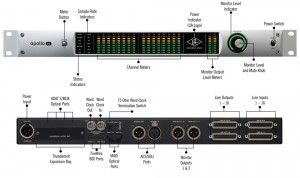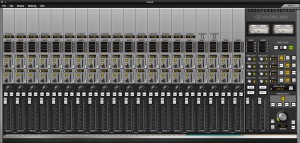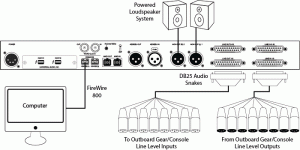Review: UA Apollo 16 by Brian Bender
My assistant recently left the rotation in the studio here to begin as a freelancer after three-and-a-half years of faithful service. We were both bummed but it was the right thing to do for his career.
A big complication about graduating into freelancing these days is the unspoken covenant that most of the actively working young engineers in New York are also almost always studio owners. Unless you have managed to find your way into one of the very few large format rooms that remain somehow or have long since passed into the freelance realm from the previous era of big budgets, you will most likely find yourself making records for your scene because you are the person that has the gear.
So, in honest acknowledgment of that fact, our conversation inevitably turned toward gear. He would either A) need to clear budgets that could support his rate as a freelancer and an additional studio rental fee or B) build a scenario that he could make work within a slightly more guerilla capacity. At home, remotely, in the van, in other people’s rooms, etc etc etc.
No news here, but if you are a young engineer, producer, or band, the democratization of recording in the digital era is endlessly rad. For less than 10 grand, you can pretty easily put together a highly workable situation for mixing and overdubs that would provide equivalent facility to an amount of analog kit that would have cost hundreds of thousands of dollars historically. A good computer, an interface, a couple of decent input channels, some cans and away you go.
So then, how do you set out to build a multitrack studio in this era that is competitive (read: can cover the monthly nut sustainably, keep you sane, and still expand), sounds good, and is malleable?
This was our particular entry point for checking out the Universal Audio Apollo 16, a 24-bit/192 kHz audio interface that’s billed as a solid centerpiece for the modern professional studio.
UNBOXING THE APOLLO 16
This past spring, on the wings of their first Apollo series interface and hugely successful and widely-loved UAD plugin platform, Universal Audio introduced this new box, a purpose built big brother to the original Apollo.
At the core of the Apollo 16, you’ll find 16 channels of digital conversion in both directions as well as a UAD|2 Quad Core DSP card to authorize and run their rad plugins.
Unboxing the interface, I was immediately struck by how tough it looks. The chassis is super rugged and the whole thing feels very well put together. On the front, you’re greeted by 16 large 10 segment LED bargraph meters, a slick, illuminated monitor volume knob, a meter switch which determines whether your metering the input or output, and power.
On the rear, you’ll of course find all the salient connectors. Audio I/O on female DB25 connectors (Tascam standard for those of you who intend to wire the multipair snakes), Monitor outputs on XLR, AES/EBU on XLR, and Clock I/O on BNC terminals (with a latching switch to provide a 75 ohm load to terminate the clock signal happily). Additionally, the data ports are found back there. There are two FireWire 800 ports, MADI and even an optional expansion card with thunderbolt for a little future proofing. The power supply is external and it runs voltage into the Apollo 16 via a 4 pin XLR.
Having the audio I/O on DB25 is a good move, in my humble opinion, as it easily interfaces with a number of standard-use boxes you may want to add to this Apollo to complete your system. Many, if not most, summing boxes take audio input on DB25. Also, many patchbays these days are wired to Tascam standard if you need additional routing capabilities in analog.
INSIDE THE BOX
On the software side, the Apollo offers a few more tricks than most convertors.
You’re probably well aware of the UAD thing if you’re reading this, but allow me to add to the growing litany of folks who believe they are some of the best plugs in the game these days. There’s the usual host of digital clones, modeling coveted metal boxes, but there are some really unexpected and hip plugs too. The Little Labs emulations, for example, or the heavily modeled Ocean Way live room verb. Neato.
Moreover, there’s a standalone console app that allows you to track through any of the UAD plugins you have installed in the machine. The outputs from the software console can then be routed into the channel ins on your preferred DAW. There are two ways to go about this, as well. You can monitor through the plug in (MON on the insert effect on the console channel) or actually record through it (REC on the insert effects switch). REC is a destructive choice, mind. The audio is actually rendered through the plug-in in real time.
This is a fucking really neat thing that I have slightly mixed feelings about. On the one hand, the production process in this era is so mired by the infinite undo, infinitely revisionist mentality that it’s incredibly refreshing to have the ability to ignore that in favor of making strong decisions on the way into the recorder. This also serves to narrow the functionality gap created by the inability of RTAS plugins to function in input monitor mode.
Moreover, speaking towards my own process, I almost always find the most inspiration by the sound design itself in part writing. It can be difficult to envision how the mellotron part will sound in context when it’s represented by a cheap MIDI piano sound, for example. So, this real time rendering option allows you to crush/distort/paisley any source on the way in and be inspired by all those colors.
In application, the real time processing had a pretty simple learning curve and, once the internal routing was all set up, functioned pretty beautifully. I tried it on a few sources and the latency was negligible in my set up. I’m most primarily a bass player, so the obvious choice for heavy scrutiny was to compress a DI on the way in. This is a particularly sensitive instrument to be dealing with latency issues (note duration and pocket being the two primary differences between passable bassists and transcendental bassists, of course) and even fast passages of grace notes found their way into the pouch where I meant for them to be.
Contrarily, I could see the ability to permanently modify audio on the way in being badly and accidentally abused. Freelance mixers getting tracks that have been compressed to the recorder with poor time constants, for example. A client being really into a smashy/distorty vocal sound until they really aren’t… Obviously, mileage will vary but these are a couple considerations that come easily to mind.
It’s also worth mentioning here that the street price of the Apollo 16 ($2,999) is competitive with the larger market of professional 16 channel interfaces, and none of them have any of the plugin capability that the Apollo 16 does. I see the plugin capability of this interface as a huge selling point as you’re getting your thing started or as a significant bonus to someone looking to upgrade to a new convertor.
I’m not the guy to lace you with superlatives (here’s the only punchy you’re gonna get in this whole article and only in a parenthetical aside) so I’ll leave the qualitative valuations of the colors this box imparts to your own adventures. Suffice it to say the sound of the conversion is useful and hi-fi and that the plugins follow suit. I’m producing a record that’s being mixed by a very high profile engineer right now and the UAD plugins are very much in a starring role in his mixes.
BEYOND THE BOX
There are a couple of disinclusions from the baby bro Apollo that are worth mentioning as well.
For example, there is no dedicated headphone out on the Apollo 16, which presupposes certain factors about how you’re going to employ the Apollo 16. In my test rig, for example, I had to connect a cheap and cheerful little Rolls headphone box or connect it to my main rig via a DB25 to bantam breakout to get the I/O into my own summing situation here.
Also, there are no dedicated mic pres on the Apollo 16, which really informs certain aspects of how the designers see this box. Removing some of those functions that the all-in-one interfaces all tout imply that they intend for it to be the center of a more realized studio situation. Why add in mic pres of questionable usefulness if you’re going to always patch around them for your Neve’s, for example?
Also, UA’s inclusion of the ability to daisy-chain two Apollo 16’s on one CPU in order to double the audio throughput and also the plug-in firepower further speaks to the way they see it fitting into the already crowded landscape of interfaces. Whereas an all-in-one interface may easily become insufficient when you want to do drums or bigger full-band dates, the Apollo 16 provides the end user with a platform to grow as necessary and tons of options for usable colors in the box.
There really isn’t anything else that covers quite the territory that the Apollo 16 does, for that reason alone. Nothing sucks worse than buying some gear you know you will outgrow and I just don’t get that vibe off of this box.
And really, the whole design speaks to the zeitgeist in a very important way. There is a gap in this particular aspect of the market that UA has correctly identified and is offering this product as a result: The need for a high quality interface that isn’t the prosumer all-in-one box and isn’t cost prohibitive when compared to the highest end stuff of forum fanboy speculation, though can create a similar level of quality.
In conclusion, I would never tell anyone to purchase a piece of gear without having heard it, but if this is something you could see fitting into your vision of your workflow, there’s a good chance it’s exactly the thing. Well built, expandable, malleable. A worthy inclusion to the already deep legacy of Universal Audio.
Brian Bender is a producer/engineer and owner of The Motherbrain Brooklyn, where he’s recently produced albums with Gabriel Gordon, Jose James, Takuya Kuroda, and Bing and Ruth.
Please note: When you buy products through links on this page, we may earn an affiliate commission.










andy
October 2, 2013 at 11:52 am (12 years ago)is this accurate? “Alternately, if you already own an original Apollo, you can significantly upgrade the throughput by adding an Apollo 16.” – thought it was a 2 x Apollo or 2 x Apollo 16 but not a mix. ?
andy
October 2, 2013 at 12:21 pm (12 years ago)thanks Brian, me neither, but I am looking 🙂
Janice Brown
October 2, 2013 at 1:15 pm (12 years ago)Actually, it is NOT accurate. (And has been removed from the piece!)
Brian Bender
October 2, 2013 at 1:21 pm (12 years ago)Apologies!! I misunderstood a note from their fact checker. He had included the fact that apollo 8’s can be stacked and the language of his wording lead me to believe it was across the two platforms. However, as Janice said below, this is inaccurate and has been removed from the review! Two Apollos can be stacked or two apollo 16’s but not one of each.
I have also put in a request to see if that is in any way possible bc I, like you seemingly, see that as a potentially rad selling point.
Dzny
October 11, 2013 at 6:53 pm (12 years ago)A computer, a DAW, really good monitors, a UA Apollo interface, plugin licenses, some channel strips or preamps, alone puts you over the “less than 10k” budget threshold easily, never mind wiring, room treatment, MICS!
Brian Bender
December 30, 2013 at 1:49 am (11 years ago)Well, man, of course it can, absolutely. We all know that an infinite budget isn’t ever good enough. As a guy sitting on well more than that in multicore in the troughs alone, I FULLY dig.
“Look, Honey! The Nelsons have a STUDER parked in their garage and we only have a Dodge”
All I’m sayin is workable. What about this build:
Apollo16 – $3k
Dope macbook pro fully ninesed on the applestore site (w/applecare)- $3,727
Dangerous Dbox- $1,400
*SUBTOTAL — $8,127
Then you have almost 2 grand ($1,873) to finalize the grab with what you need most to cover the gig at that moment. MAKE the cables (yes. because.), Grab some dope open back cans and a couple plugins and you have an instantly cool mix rig in a whatever sounding room. Grab some sony mvr’s and a bunch of 57’s and 58’s and some just cheap and cheerful mic pres and some packing blankets and instant writing rig. Or one cool tube mic and a one cool pre for vox and gtr, vibey mono drums or something. Or if you are like me, hound it up on ebay and score some super cool vintage shit and start building an aesthetic. Or DIY it? Also, maybe you have a workable computer already? Know what I mean? I kind of assume that you’ll be bringing some stuff to the party already. Anyone reading this would be, no?
Then, immediately reinvest all the money you make off of said rig into said rig for as long as your pants can hold out, just like the rest of us. 😀
marko
January 30, 2015 at 10:49 pm (10 years ago)how to hook up headphones